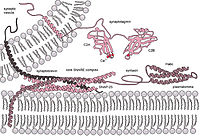
Photo from wikipedia
ABSTRACT Bispecific antibodies have emerged as therapeutic molecules with a multitude of modes of action and applications. Here, we present a novel approach to solve the light-chain problem for the… Click to show full abstract
ABSTRACT Bispecific antibodies have emerged as therapeutic molecules with a multitude of modes of action and applications. Here, we present a novel approach to solve the light-chain problem for the generation of bispecific Ig-like antibodies using the second constant domain of IgE (EHD2) genetically modified to force heterodimerization. This was achieved by introducing a C14S mutation in one domain and a C102S mutation in the other domain, which removed of one of the crossover disulfide bonds. Substituting the CH1 and CL domains of an antigen binding fragment (Fab) with these heterodimerizing EHD2 (hetEHD2) domains resulted in Fab-like building blocks (eFab). These eFabs were used to generate different bispecific antibodies of varying valency and molecular composition employing variable domains with different specificities and from different origins. Formats included bivalent bispecific IgG-like molecules (eIgs) and Fc-less Fab-eFab fusion proteins, as well as tri- and tetravalent Fab-eIg fusion proteins. All proteins, including bispecific antibodies for dual receptor targeting and for retargeting of T cells, efficiently assembled into functional molecules. Furthermore, none of the hetEHD2-comprising molecules showed binding to the two Fcε receptors and are thus most likely do not induce receptor cross-linking and activation. In summary, we established the eIg technology as a versatile and robust platform for the generation of bispecific antibodies of varying valency, geometry, and composition, suitable for numerous applications. Abbreviations: antibody drug conjugate (ADC), acute lymphocytic leukemia (ALL), constant domain of IgE (Cε), receptor of Cε (CεRI or CεRII), cluster of differentiation (CD), constant domain of heavy chain (CH), constant domain of light chain (CL), (single-chain) diabody ((sc)Db), diabody-immunoglobulin (Db-Ig), dynamic light scattering (DLS), Fragment antigen-binding (Fab), Fab with hetEHD2 (eFab), Fab-EHD2 with T121G in chain 1 and S10I in chain 2 (EFab), bispecific Ig domain containing hetEHD2 (eIg), extracellular domain (ECD), epidermal growth factor receptor 1, 2, 3 (EGFR, HER2, HER3), heavy chain domain 2 of IgE (EHD2), EHD2 domain with C102S (EHD2-1), EHD2 domain with C14S and N39Q (EHD2-2), (human or mouse) fragment crystalline ((hu or mo)Fc), heavy chain (HC), heterodimerized second domain of IgE (hetEHD2), high molecular weight (HMW), immunoglobulin (Ig), light chain (LC), liquid chromatography-mass spectrometry (LC-MS), mesenchymal epithelial transition factor (MET), heavy chain domain 2 of IgM (MHD2), peripheral blood mononuclear cell (PBMC), prolactin receptor (PRLP), Stokes radius (RS), single-chain Fragment variable (scFv), tumor necrosis factor (TNF), TNF receptor 2 (TNFR2), single-chain TNF-related apoptosis-inducing ligand (scTRAIL), variable domain of heavy chain (VH), variable domain of light chain (VL).
Journal Title: mAbs
Year Published: 2022
Link to full text (if available)
Share on Social Media: Sign Up to like & get
recommendations!